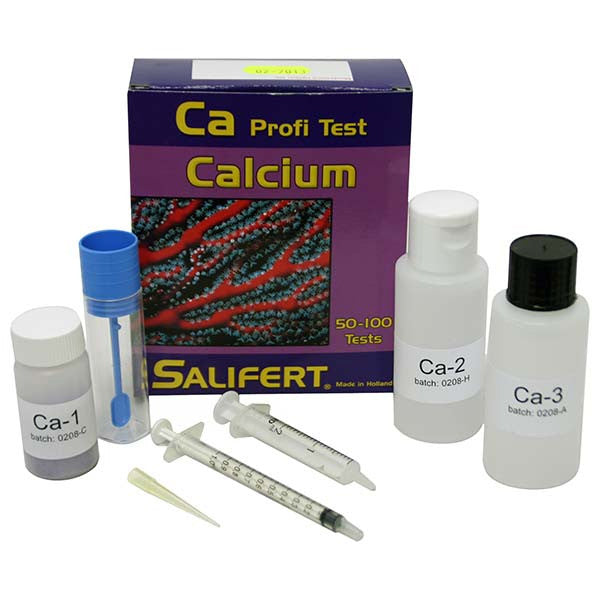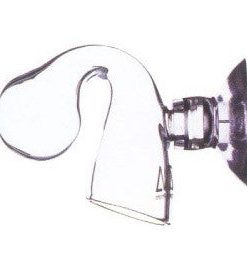Salifert Calcium Profi Test Salifert
$ 29,80 $ 17,88
Calcium is a major constituent of coralline algae, the skeletal material of hard corals and the skeletal needles of soft/leather corals. In many cases too low a calcium concentration retards coral and coralline algae growth.
Calcium also fulfills many important biological functions.
In a healthy aquarium, the growth and multiplication of corals, calcareous algae and other organisms can result in calcium depletion. To maintain a stable environment it is important that the calcium content should not fluctuate by more than 15 mg/L from the optimum range of 420 – 450 mg/L so regular testing should be carried out.
This means that any calcium test used should have an accuracy of significantly less than 15mg/L otherwise it will be difficult to monitor such fluctuations.
The Salifert test kit measures in steps of 5 mg/L and has an accuracy of 10 mg/L.
The color change is precise, detecting small but significant fluctuations in the concentration of calcium.
The test is not affected by magnesium.
Sufficient for 50-100 tests.
Can be used for marine water, freshwater and garden pond water
Warning!
Ca-1 reagent contains sodium hydroxide and is strongly irritating to skin and eyes. In case of contact with skin wash with plenty of water. In case of contact with the eyes wash with plenty water and consult a physician immediately.
Not for consumption. Keep out of reach of children. If swallowed contact a physician immediately.
INSTRUCTIONS for usage.
- Add with 2ml of water in the test vial. For a lower resolution and more test per kit add 1ml instead of 2ml.
- Add one level spoon of Ca-1 (low resolution approx 1/2 spoon). Do not mix it yet.
- Add 8 drops of Ca-2. The low resolution mode requires 4 drops. Swril (DO NOT SHAKE) for 10 seconds.
- Put the plastic tip firmly on the 1ml syringe. And draw into the syringe the CA-3 reagent (ensure that the end of the plastic tipis constantly submersed in the Ca-3 reagent)till the lower end of the black part of the piston is exactly at the 1.00ml mark. There will besome air present just below the piston. This is the air which was present between the end of the plastic tip and the piston. This will not influence the test result.
- Add dropwise with the 1ml syringe the Ca-3 reagent to the water in the tst tube. Swirl after each drop a second or two. Continue with this until the colour changes from pink-red to a clear blue colour.
- Hold the syringe with the tip facing upwards and read the position of the, now the upper end, of the black part of the piston. The syringe has graduations of 0.01ml. Read the calcium value from the table or calculate as follows.
- ppm Ca = (1- reading in step 6) x 500. If you have chosen for the lower resolution, multiply the calculated results by 2
Natural seawater contains 400 – 425 ppm calcium.
Fast Shipping and Professional Packaging
We can offer a variety of shipping options thanks to our long-term relationship with UPS FedEx DHL. Our warehouse staff will package all goods to our exacting requirements. Prior to shipping, your goods will be thoroughly examined and securely secured. We deliver to thousands of customers every day from all over the world. This is a sign of our determination to be the largest online retailer in the world. Warehouses and distribution centers are located throughout Europe as well as in the USA.
Note: Orders that contain more than one item will be assigned a separate processing time for each item.
Prior to shipment, we examine the items ordered thoroughly before sending the items. Most orders are shipped within 48 hours. The expected delivery time is 3 to 7 days.
Returns
The stock is constantly changing and cannot be fully controlled by us due to the involvement of many different parties, such as the factory and our warehouse. The levels of stock can change at any moment. You may not receive your order once the order has been made.
The policy is 30 days. If it's been longer than 30 days since you made your purchase and we're unable to offer you a complete exchange or refund.
To be eligible for a return your item must be unused and in the same condition as you received it. You must have the item in its original packaging.
Related products
Bacteria
Air Pump Accessories
CO2 Accessories
Plant Fertilisation
Air Pump Accessories
Bacteria
Filter Media
Substrate
Conditioner
Uncategorized
Filter Media
Freshwater Plant
Maintenance Tools
Plant Fertilisation
Plant Fertilisation
Bacteria
Plant Fertilisation
Freshwater Plant
RO/DI
Substrate







































